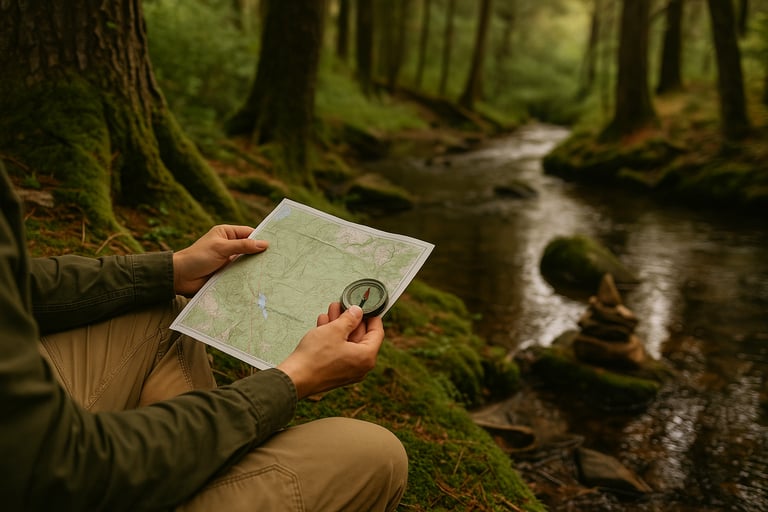Top 5 Orienteering Skills Everyone Should Know for Wilderness Survival
Mastering orienteering skills can be a lifesaver in the wild. Learn five essential navigation techniques every survivalist should know, including map reading, compass use, terrain association, and more.


Top 5 Orienteering Skills Everyone Should Know for Wilderness Survival
Introduction to Orienteering for Wilderness Survival
For wilderness survival, the ability to navigate without digital tools isn’t just a nice-to-have, it’s a core survival skill. Whether you're exploring deep woods or trekking across mountain ridges, orienteering can mean the difference between getting home safely or getting lost. Orienteering skills for survival includes the art of navigating with a map and compass, and when combined with survival skills, it becomes an essential part of your backcountry toolkit.
Let’s break down five of the most important wilderness survival orienteering techniques every survivalist should understand.
Reading a Topographic Map
A topographic map shows more than just where things are — it tells you what the terrain feels like underfoot. Learning how to read contour lines helps you visualize hills, valleys, ridgelines, and flat areas. Close lines mean steep terrain, while wide spaces indicate gentle slopes or flat ground. Identifying landmarks like rivers, saddles, or cliffs can help you match your surroundings to the map and stay oriented even in remote wilderness areas. To dive deeper into map reading, check out our full guide on how to read a topographic map for wilderness navigation.
Mastering Compass Navigation
A compass becomes your best friend when navigating unknown terrain. Knowing how to set a bearing, follow a heading, and adjust for magnetic declination helps you move in a straight line and reach your destination safely. Combined with a map, a compass can pinpoint your location or help you navigate when visibility drops. Practice taking bearings from visible landmarks and transferring those to your map, it’s one of the most useful skills for survival navigation. Make sure you also understand how magnetic declination affects your compass readings — a crucial adjustment for accurate navigation.
Using Landmarks and Terrain Association
Orienteering isn’t just about staring at a map — it’s also about reading the land in front of you. This is where terrain association comes in. Learn to associate what you see around you (like a ridgeline, hilltop, or river bend) with features on your map. Large natural features such as cliffs, valleys, or lakes are reliable navigation references even without a compass. The more you study the terrain while on the move, the better your ability to estimate your position.
Pacing and Estimating Distance
Knowing how far you’ve traveled can make a huge difference when navigating through the wilderness. It helps you avoid overshooting your destination, retrace your steps, or estimate how much farther you have to go. One of the most reliable ways to measure distance on foot is by counting your steps, a technique called pacing.
To get started, measure out a distance of 100 meters on flat ground (like a track or straight trail) and walk it at a natural pace. Count every time your right foot touches the ground. That number becomes your personal pace count for 100 meters — for example, 65 steps. Then when you're actually on the trail, you’ll have a way of knowing when you’ve covered about 100 meters, its every time you count that many steps.
Of course, your stride will change depending on the terrain. Uphill sections, thick brush, or uneven ground can shorten your stride and increase your step count. With practice, you can learn to adjust your pace count for different environments and estimate distances more accurately. You can also combine pacing with a watch (to estimate how long you’ve been hiking) and your map’s scale. Together, these methods help you track your movement and stay oriented — especially in areas where landmarks are sparse or the trail isn’t clearly marked.
Backstop and Handrail Techniques
Backstops are natural or manmade features that act as safety nets — like a trail, river, or cliff that tells you you've gone too far. Handrails are linear features you can follow, such as streams or ridges, that run parallel to your intended route. These strategies help keep you on track and make it easier to recover if you stray off course. Both techniques are simple yet powerful ways to navigate effectively without needing constant precision. Following cairns and trail markers can serve as excellent visual handrails in rough terrain.
Final Thoughts on Orienteering for Survival
Like any survival skill, orienteering improves with hands-on practice. Take your map and compass to local trails or state parks and start applying these five techniques. Over time, they’ll become second nature and they just might save your life when technology fails or conditions take a turn for the worse. The more confident you become in traditional navigation methods, the more prepared you’ll be in any wilderness situation. If you ever do lose your way, knowing what to do if you're lost in the wilderness can make all the difference.




© 2025. All rights reserved About | Privacy Policy | Terms and Conditions | Affiliate Disclosure | Disclaimer


